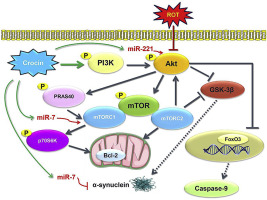当前位置:
X-MOL 学术
›
Neuropharmacology
›
论文详情
Our official English website, www.x-mol.net, welcomes your
feedback! (Note: you will need to create a separate account there.)
Neuroprotective effect of crocin against rotenone-induced Parkinson's disease in rats: Interplay between PI3K/Akt/mTOR signaling pathway and enhanced expression of miRNA-7 and miRNA-221.
Neuropharmacology ( IF 4.6 ) Pub Date : 2019-12-05 , DOI: 10.1016/j.neuropharm.2019.107900 Rania M Salama 1 , Ghada A Abdel-Latif 1 , Samah S Abbas 1 , Hekmat M El Magdoub 2 , Mona F Schaalan 3
Neuropharmacology ( IF 4.6 ) Pub Date : 2019-12-05 , DOI: 10.1016/j.neuropharm.2019.107900 Rania M Salama 1 , Ghada A Abdel-Latif 1 , Samah S Abbas 1 , Hekmat M El Magdoub 2 , Mona F Schaalan 3
Affiliation

|
The complexity of Parkinson's disease (PD) pathogenesis is attributed to multiple pathways involved in the neurodegeneration process. Among these pathways arise the phosphoinositide 3-kinase (PI3K)/protein kinase B (Akt), and mammalian target of rapamycin (mTOR) axis, where inhibition of this cascade has been implicated in the pathogenesis of PD. Crocin, a carotenoid found in saffron, has shown beneficial effects against neurodegenerative diseases via anti-apoptotic, anti-inflammatory, and antioxidant activities. However, the exact molecular pathways involved in crocin's neuroprotective effects have not been fully elucidated. This drove our attention to unravel the possible involvement of PI3k/Akt/mTOR pathway in the neuroprotective effect of crocin against rotenone (ROT)-induced PD in rats. Sixty adult male Wistar rats were divided into four groups: control, crocin (30 mg/kg/day; i.p.), ROT (1.5 mg/kg/day, i.p.) and ROT pre-treated with crocin for 30 days. Crocin administration showed a substantial behavioral improvement. At the cellular level, crocin significantly stimulated the PI3K/Akt pathway, augmented phospho-proline-rich Akt substrate 40 kDa (p-PRAS40), mTOR and p-p70S6K levels. Consequently, glycogen synthase kinase-3β (GSK-3β), forkhead box transcription factor of the O class (FoxO3a), and the downstream caspase-9 were decreased; thus, attenuating neurodegeneration, which was witnessed through increased tyrosine hydroxylase (TH) and dopamine (DA), and hampered α-synuclein levels. Moreover, crocin showed enhanced expression of microRNA-7 (miRNA-7) and miRNA-221, which contributed to Akt/mTOR activation. These results were verified by improved histopathological portrait and increased number of intact neurons. In conclusion, crocin showed promising neuroprotective effects in ROT-induced PD via activation of PI3K/Akt/mTOR axis and enhanced miRNA-7 and miRNA-221.
中文翻译:

番红花对大鼠鱼藤酮诱导的帕金森氏病的神经保护作用:PI3K / Akt / mTOR信号通路与miRNA-7和miRNA-221增强表达之间的相互作用。
帕金森氏病(PD)发病机理的复杂性归因于神经退行性过程涉及的多种途径。在这些途径中,出现了磷酸肌醇3-激酶(PI3K)/蛋白激酶B(Akt),和雷帕霉素(mTOR)轴的哺乳动物靶标,其中这种级联的抑制作用与PD的发病机理有关。藏红花中的类胡萝卜素-番红花通过抗凋亡,抗炎和抗氧化活性,已显示出对神经退行性疾病的有益作用。但是,尚未完全阐明与番红花的神经保护作用有关的确切分子途径。这驱使我们注意揭示PI3k / Akt / mTOR途径可能参与了番红花对大鼠鱼藤酮(ROT)诱导的PD的神经保护作用。将60只成年雄性Wistar大鼠分为四组:对照组,番红花(30 mg / kg /天;腹膜内),ROT(1.5 mg / kg /天,腹膜内)和用番红花预处理30天的ROT。番红花给药表现出实质性的行为改善。在细胞水平上,藏红花酸显着刺激PI3K / Akt途径,使富含磷酸脯氨酸的Akt底物增加40 kDa(p-PRAS40),mTOR和p-p70S6K水平。因此,糖原合酶激酶3β(GSK-3β),O类叉头盒转录因子(FoxO3a)和下游半胱天冬酶9降低。因此,可通过增加酪氨酸羟化酶(TH)和多巴胺(DA)并抑制α-突触核蛋白水平来减弱神经变性。此外,番红花显示出microRNA-7(miRNA-7)和miRNA-221的表达增强,这有助于Akt / mTOR激活。通过改善组织病理学肖像和增加完整神经元数量可以证实这些结果。总之,番红花通过激活PI3K / Akt / mTOR轴和增强的miRNA-7和miRNA-221在ROT诱导的PD中显示出有希望的神经保护作用。
更新日期:2019-12-05
中文翻译:

番红花对大鼠鱼藤酮诱导的帕金森氏病的神经保护作用:PI3K / Akt / mTOR信号通路与miRNA-7和miRNA-221增强表达之间的相互作用。
帕金森氏病(PD)发病机理的复杂性归因于神经退行性过程涉及的多种途径。在这些途径中,出现了磷酸肌醇3-激酶(PI3K)/蛋白激酶B(Akt),和雷帕霉素(mTOR)轴的哺乳动物靶标,其中这种级联的抑制作用与PD的发病机理有关。藏红花中的类胡萝卜素-番红花通过抗凋亡,抗炎和抗氧化活性,已显示出对神经退行性疾病的有益作用。但是,尚未完全阐明与番红花的神经保护作用有关的确切分子途径。这驱使我们注意揭示PI3k / Akt / mTOR途径可能参与了番红花对大鼠鱼藤酮(ROT)诱导的PD的神经保护作用。将60只成年雄性Wistar大鼠分为四组:对照组,番红花(30 mg / kg /天;腹膜内),ROT(1.5 mg / kg /天,腹膜内)和用番红花预处理30天的ROT。番红花给药表现出实质性的行为改善。在细胞水平上,藏红花酸显着刺激PI3K / Akt途径,使富含磷酸脯氨酸的Akt底物增加40 kDa(p-PRAS40),mTOR和p-p70S6K水平。因此,糖原合酶激酶3β(GSK-3β),O类叉头盒转录因子(FoxO3a)和下游半胱天冬酶9降低。因此,可通过增加酪氨酸羟化酶(TH)和多巴胺(DA)并抑制α-突触核蛋白水平来减弱神经变性。此外,番红花显示出microRNA-7(miRNA-7)和miRNA-221的表达增强,这有助于Akt / mTOR激活。通过改善组织病理学肖像和增加完整神经元数量可以证实这些结果。总之,番红花通过激活PI3K / Akt / mTOR轴和增强的miRNA-7和miRNA-221在ROT诱导的PD中显示出有希望的神经保护作用。











































 京公网安备 11010802027423号
京公网安备 11010802027423号